Capsule Review: EVGA GeForce GTX 780 Superclocked ACX
by Ryan Smith on September 22, 2013 12:00 PM ESTOverclocking
Having taken a look at stock performance, let’s dive into overclocking quickly. Since the 780SC ACX is based on the reference board design it has the same limits as the reference GTX 780 when it comes to overclocking. The max TDP is just 106%, and the max voltage is 1.2v. As a result overclocking headroom won’t be very different from the reference GTX 780, with the ACX cooler and EVGA’s superclocked binning being the only significant differences from a reference card.
| EVGA GeForce GTX 780SC ACX Overclocking | |||||
| Stock | Overclocked | Ref GTX 780 OC | |||
| Core Clock | 967MHz | 1042MHz | 1063MHz | ||
| Boost Clock | 1020MHz | 1095MHz | 1102MHz | ||
| Max Boost Clock | 1123MHz | 1215MHz | 1228MHz | ||
| Memory Clock | 6GHz | 6.8GHz | 7GHz | ||
| Max Voltage | 1.162v | 1.2v | 1.2v | ||
In the end even with binning in play the 780SC ACX isn’t capable of overclocking any higher than our reference GTX 780; in fact it’s a hair worse, with the 780SC ACX topping out at 19MHz less than the reference GTX 780. So from a clockspeed perspective this is a wash. Pushing any higher will require more TDP headroom and more voltage, which in turn will require a fully custom design.
At the same time given the fact that EVGA has already eaten into a lot of the GTX 780’s overclocking headroom with their factory overclock, this means there’s not as much overclocking headroom available for the end user. 967MHz to 1042MHz is still a free 8% increase in clockspeeds; the payoff just isn’t as great as relative to a stock GTX 780.
Moving on, as a result of their similar overclocks, overclocked performance is virtually indistinguishable from our overclocked GTX 780. Despite the ACX cooler keeping temperatures in the low 70s we’re primarily power constrained here, which isn’t something the ACX cooler can help with.
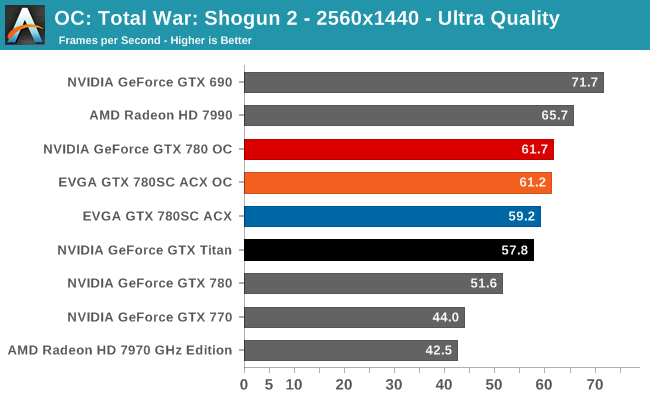
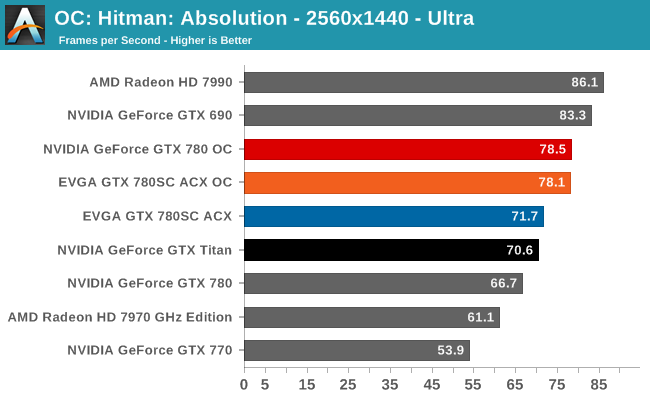
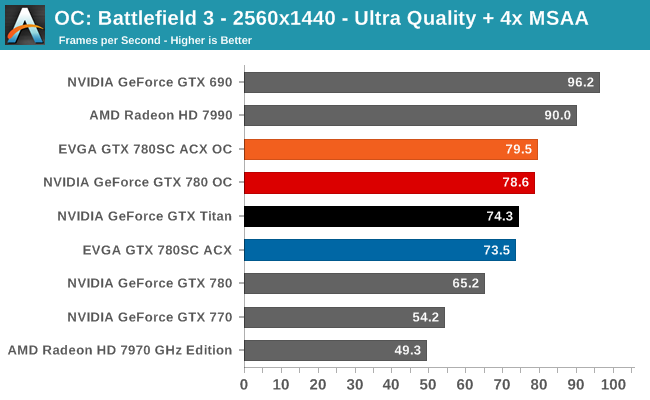
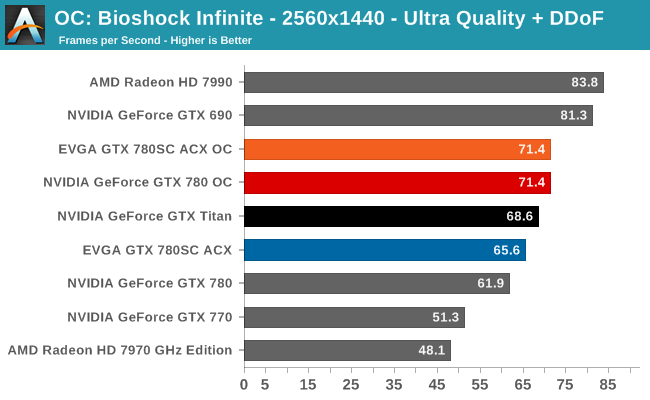
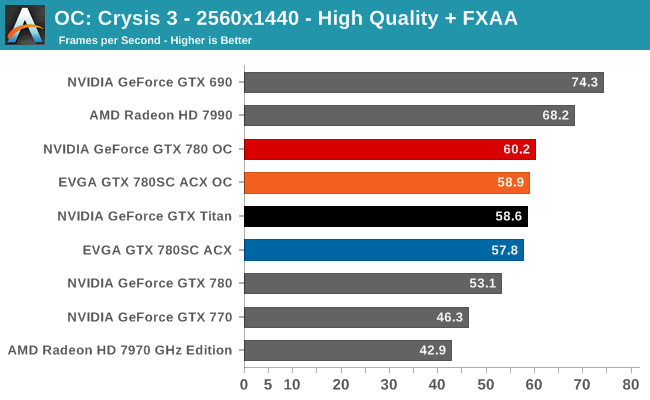
As was the case with overclocking the reference GTX 780, the payoff here is GPU performance that’s well ahead of the GTX 780 at stock, and performance that exceeds even GTX Titan by around 7%.
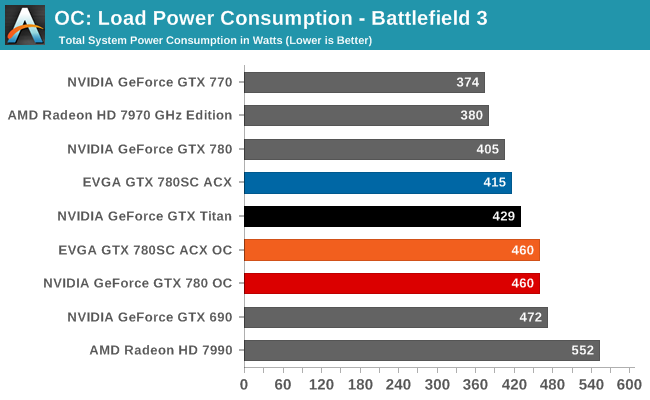
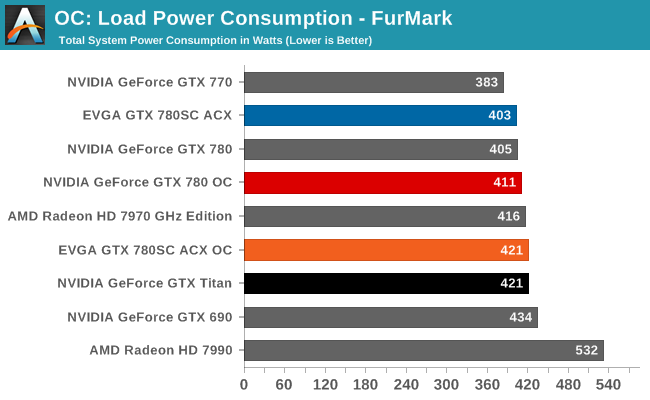
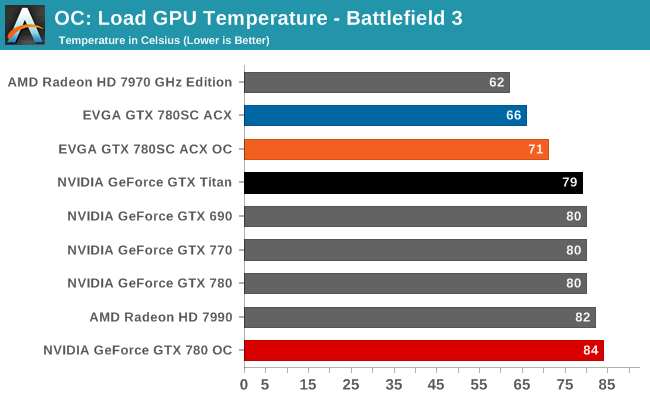

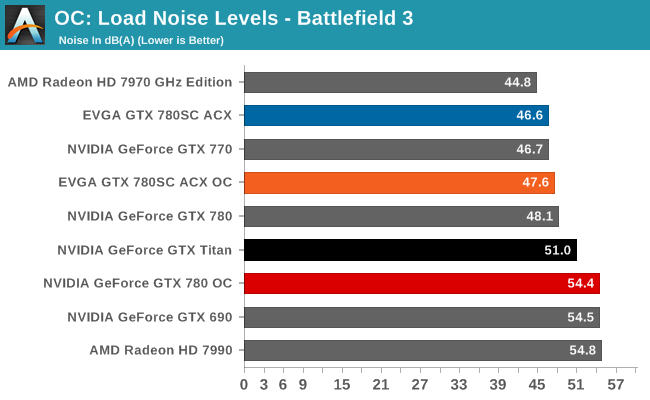
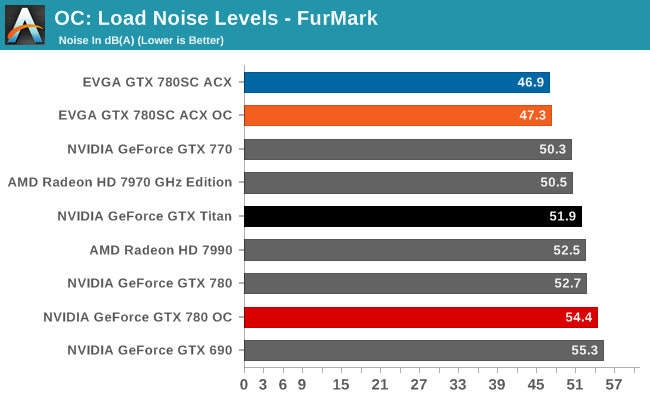
Finally, quickly taking a look at power, temp, and noise after overclocking we can see that the 780SC ACX maintains its strong cooling performance, with temperatures topping out in the low 70s and noise levels rising by just 1dB. The power cost of overclocking is fairly high however, thanks to the use of higher voltage boost bins.
All told, the 780SC ACX’s sweet spot is going to be at stock. While it’s as good an overclocker as any reference GTX 780, the fact that EVGA gives you so much of its overclockability out of the box with a trivial power cost means that the benefits of squeezing out the last bit of headroom don’t pay off quite as nicely here as with a stock card. The ACX cooler will have no problem keeping temperatures and noise levels down however, which means being able to reap the benefits of GTX 780 overclocking without the noise penalty.
Final Words
Wrapping things up, it’s clear that EVGA has put together an extremely solid card with their GeForce GTX 780 Superclocked ACX, both on the basis of performance and relative value. As we alluded to at the start of this article, EVGA is offering a sizable factory overclock for an absolutely tiny price premium, and as a result the 780SC ACX looks extremely good on a price/performance basis. For $10 more than a stock GTX 780 the 780SC ACX delivers 10% better performance, does so with just a trivial increase in power consumption, and ultimately closes the performance gap with GTX Titan. On this basis the 780SC ACX is a much better value proposition than your typical factory overclocked card, to the point where the stock card rarely makes sense. For all practical purposes the stock GTX 780 has been rendered redundant because of this.
Clockspeeds and prices aside, the other matter at hand is EVGA’s new ACX cooler. As yet another twin fan open air cooler the ACX cooler isn’t going to be groundbreaking, but that hasn’t stopped EVGA from taking the basic principles of the design and put together a very solid cooler. The build quality itself is quite good, and although this doesn’t match the metal madness that is the reference GTX 780, the ACX is as sturdy as any open air cooler can hope to be. Meanwhile in making the usual tradeoffs that come with the design, the ACX cooler offers notably better cooling than the GTX 780’s reference cooler, sustaining lower temperatures and less noise than its blower based counterpart. It goes without saying that for systems that can support this style cooler this is a very good tradeoff to make.
With that in mind, EVGA is off to a good start with their new cooler. If EVGA can sustain this level of quality and performance across their product tiers, then EVGA should have no trouble at all achieving their goals and broadening their reach into open air cooling.


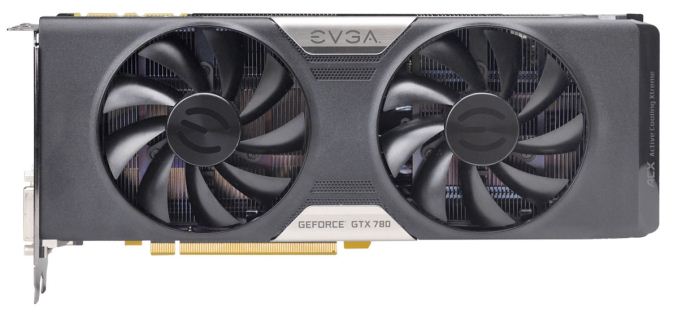








40 Comments
View All Comments
alkhanzi - Wednesday, September 25, 2013 - link
Comparing the above given benchmarks the 7990 is more than 20% faster in average than the 780 at 2560*1440. As of today in newegg the price is 620USD. So I will choose 20% more FPS and 20 USD less price 10 times out of 10 :)tackle70 - Wednesday, September 25, 2013 - link
The limited test suite here favors the 7990http://www.techpowerup.com/reviews/EVGA/GTX_780_SC...
GeorgeH - Monday, September 23, 2013 - link
The Titan is still incredibly relevant and important for Nvidia - for psychological reasons.The Titan at $1000 makes this card a "good deal". When Titan came out every review had a "but the price!" as a negative. If the Titan did not exist every 780 review would have the same caveat. Instead every 780 review has a "it's a great deal on a Titan" comment.
Intel does the same thing with its $1000 -X CPUs; the 4930K is a "good deal" on a 4960X. It's a sales technique widely used across all industries because it works incredibly well.
Bottom line Nvidia isn't marketing the Titan to "prosumers" or whatever else, they're marketing it to 780 customers.
colonelclaw - Tuesday, September 24, 2013 - link
I love Nvidia graphics cards, and have historically bought their top-of-the-range card every two generations, but this time out I think they've completely lost the plot on price. I remember thinking £350 here in the UK was an outrageous price when I bought my 580, but a 780 is now £500+ and it's not even their best single-GPU gaming card. Shouldn't the price stay pretty much the same for the top card across generations (inflation-adjusted)? Plotting a graph of performance increases per generation going back many generations pretty much shows the Titan should be branded the 780.I'd be interested to see their sales figures, but I can't imagine they're selling anything like as many 780s as they did 580s. And as for Titans, niche would have to be an understatement.
Jodiuh - Tuesday, September 24, 2013 - link
I don't know how you're testing this card or perhaps you got a VERY cherry picked card, but I load @ 77C and so does a friend's card. Also, this cooler is noisy. Your review conflicts heavily with xbit labs, hardware canucks, and what I've seen on two of these cards.tackle70 - Tuesday, September 24, 2013 - link
I have two of these in SLI, and they're dead silent - never louder than my NH-D14 CPU cooler. Top card never goes over 70C at stock settings. Guru3d, TPU, and others corroborate the noise results. The cooler is not noisy at all.rs2 - Tuesday, September 24, 2013 - link
Would anyone care to explain how those FP64 ratings work? Specifically the things like "1/3 FP32" and "1/24 FP32". Seems like gibberish to be, though I assume one is better than the other, by some amount that can be inferred by comparing the fractions?Oscarcharliezulu - Friday, September 27, 2013 - link
Give the card works within its thermal limits even under boost, can you underclock or reduce the base speed to make it even quieter and cooler when not gaming, but utilise full speed when playing a game? Do the utilities let you do that?jdietz - Tuesday, October 1, 2013 - link
Where do I go to see the test setup (CPU, etc...)?Laststop311 - Sunday, October 6, 2013 - link
All these cards basically have right about the same speed and frame rates. The all can overclock very close to one another. The only things that really matter are the cooling capability and the noise level. The quietest/coolest gtx 780 is either the Asus Direct CU II with the updated BIOS or the MSI Gamer N780. Going with one of these cards gives you the lowest temp to noise ratio which is really the only different things between these cards. Plus the MSI Gamer N780 is on the cheaper end of the scale.